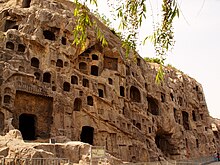Longmen Grottoes
| Longmen Grottoes | |
|---|---|
|
UNESCO world heritage |
|

|
|
| Fengxian temple |
|
| National territory: |
|
| Type: | Culture |
| Criteria : | i, ii, iii |
| Reference No .: | 1003 |
| UNESCO region : | Asia and Pacific |
| History of enrollment | |
| Enrollment: | 2000 (session 24) |
The Longmen Grottoes (also Dragon Gate Grottoes , Chinese 龙门 石窟 , Pinyin lóngmén shíkū ) on the Yi River 13 kilometers south of the old capital Luoyang are among the four most famous Buddhist grottoes in China, the other three are the Mogao Grottoes in Dunhuang , which Yungang grottoes in Datong and the plus grottoes in Chongqing .
The grottos are located in the Yihe River Valley between the Scent Mountain and the Longmen Mountain . The construction of the grottoes began in the Northern Wei Dynasty and lasted about 400 years until the Tang Dynasty . There are a total of 2,345 niches, over 100,000 statues of Buddha and more than 2,800 inscriptions. The largest statue is the 17.14 meter high Buddha Vairocana and the smallest micro-engraved Buddha figure is only 2 centimeters high.
Main grottos
The main grottos are as follows (the dates in brackets indicate the beginning of their design):
- 古 阳 洞 Guyang-dong (493),
- 宾阳 洞 Binyang-dong (505),
- 莲花洞 Lianhua-dong (520),
- Shiku-si (520er),
- 魏 字 洞 Weizi-dong (520er),
- Shisiku (520er),
- 药方 洞 Yaofang-dong (570),
- Zhaifu-dong (about 636),
- 惠 简 洞 Huijian-dong (630s),
- Fahua-dong (650s),
- 奉先 寺 Fengxian-si (672),
- 万佛寺 Wanfo-si (670-680s),
- 极 南 洞 Jinan-dong (684),
- Ganjing-si (684) and
- 擂鼓 台 洞 Leigutai-dong (684). [11]
history
Construction of the caves began in 493 , during the Northern Wei Dynasty, and continued for over 400 years. One of the sponsors of the site was China's only (self-sufficient) Empress Wu Zetian .
The river banks of the Yi are designed as promenades in the area of the grottoes. The grottoes have been on the list of monuments of the People's Republic of China in Henan (1-37) since 1961
At the time of the Cultural Revolution , many Buddha images were destroyed or badly damaged. But also the weather, vandalism and, last but not least, art thieves from all over the world had their share in the destruction or plundering of the grottoes. Most of the grottos are located on the steep western bank of the Yi River. On the eastern bank, the Xiangshan Temple was reconstructed around the turn of the last millennium. Its building complex also includes the former villa of Chiang Kai-shek and Madame Chiang (Jiangsong). The Baiyuan Garden, also on the east bank of the Longmen, contains the mausoleum of Bai Juyi , a famous poet of the Tang Dynasty .
The caves were in 2000 to UNESCO - World Heritage declared.
Great Vairocana
literature
- Henan Administration of Cultural Heritage (Ed): Henan - China. The Cradle of Huaxia Civilization , 2012, ISBN 978-7-5510-0162-5
Web links
Individual evidence
- ↑ UNESCO World Heritage Center: Longmen Grottoes. Accessed August 17, 2017 .
Coordinates: 34 ° 28 ′ 0 ″ N , 112 ° 28 ′ 0 ″ E












